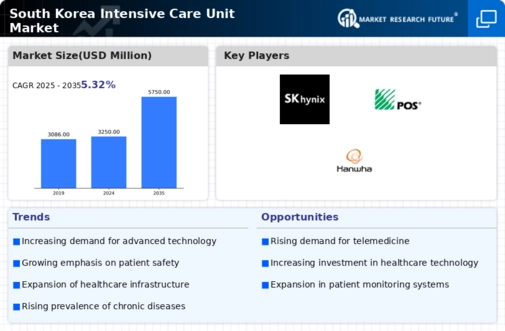Aging Population
The demographic shift towards an aging population in South Korea has a significant impact on the intensive care unit market. By 2025, it is projected that over 20% of the population will be aged 65 and older, a demographic that typically requires more intensive medical care. This increase in the elderly population correlates with a higher incidence of age-related health issues, which often necessitate admission to intensive care units. Consequently, healthcare providers are likely to expand their intensive care facilities and services to meet this demand. The aging population drives the need for more intensive care beds. It also emphasizes the necessity for specialized care tailored to the unique needs of older patients. This demographic trend is expected to shape the future landscape of the intensive care-unit market.
Government Healthcare Initiatives
Government initiatives aimed at improving healthcare infrastructure in South Korea are a crucial driver for the intensive care-unit market. Recent policies have focused on enhancing the quality of healthcare services, including the expansion of intensive care facilities. The government has allocated substantial funding, estimated at over $1 billion, to upgrade existing hospitals and build new intensive care units. These initiatives aim to ensure that healthcare providers can deliver high-quality care to patients in critical conditions. Furthermore, the emphasis on public health and safety is likely to lead to increased regulatory standards for intensive care units, thereby fostering a more robust market environment. As these initiatives unfold, they are expected to stimulate growth and innovation within the intensive care-unit market.
Rising Prevalence of Chronic Diseases
The increasing prevalence of chronic diseases in South Korea is a primary driver for the intensive care-unit market. Conditions such as diabetes, cardiovascular diseases, and respiratory disorders are on the rise, necessitating advanced medical care. According to recent health statistics, approximately 30% of the population suffers from at least one chronic illness, leading to a higher demand for intensive care services. This trend indicates that healthcare facilities must enhance their intensive care capabilities to accommodate the growing patient load. As a result, investments in state-of-the-art equipment and specialized staff are likely to increase, further propelling the intensive care-unit market. The need for effective management of these chronic conditions underscores the importance of intensive care units in providing timely and specialized treatment.
Technological Integration in Healthcare
The integration of advanced technologies in healthcare transforms the intensive care unit market. Innovations such as telemedicine, artificial intelligence, and advanced monitoring systems are becoming increasingly prevalent in intensive care settings. These technologies enhance patient monitoring and improve decision-making processes for healthcare professionals. For instance, the use of AI-driven analytics can lead to better patient outcomes by predicting complications and optimizing treatment plans. As hospitals in South Korea adopt these technologies, the demand for sophisticated intensive care units is likely to rise. This trend suggests that the intensive care-unit market will continue to evolve, driven by the need for more efficient and effective patient care solutions.
Increased Awareness of Critical Care Services
There is a growing awareness among the South Korean population regarding the importance of critical care services, which is positively influencing the intensive care-unit market. Public health campaigns and educational initiatives have highlighted the role of intensive care units in saving lives and improving health outcomes. As a result, patients and families are more likely to seek specialized care when faced with severe health issues. This heightened awareness is expected to lead to an increase in patient admissions to intensive care units, thereby driving market growth. Additionally, healthcare providers are likely to respond by enhancing their intensive care services to meet the rising expectations of patients and their families, further solidifying the market's expansion.














Leave a Comment